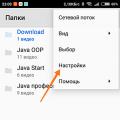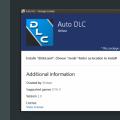Surely many have heard of the Microsoft .NET libraries, which are often the core of various applications. The interaction between the software that uses it and the libraries themselves is carried out through the .NET Framework system components. Without them, many applications simply will not install.
The current versions of the .NET Framework are 4.6 And 4.7 , which also includes the old edition 4.5 . They are built into Windows 10, and you should not have any problems installing or using them. The situation is different with already outdated version 3.5 . It has been widely used in Windows times 7 and is not compatible with .NET Framework 4.x. Since the 3.5 edition is not included with Windows 10 by default, many older programs simply won't install.
How to download and install .NET Framework 3.5 on Windows 10
The developers have provided an option to install an old version of the .NET Framework in the service Windows components 10. You will need an internet connection to download the library.
How to download the .NET Framework 3.5 installer for Windows 10
If for some reason you cannot use the Windows Component Service, you have the option to download and run the .NET Framework 3.5 online installer.

How to install .NET Framework 3.5 without internet (offline)
Sometimes when using the Center web service windows updates problems occur and users cannot install the .NET Framework 3.5 using the two methods described above. In such case you can use bootable flash drive With way Windows 10 for manual installation component (without the need for an internet connection).

Therefore, the .NET Framework 3.5 can be installed without using an Internet connection or Windows Update services.
NET Framework (Dot Net Framework) - software platform(software framework) developed by Microsoft Corporation in 2002, primarily for the operating Microsoft systems Windows. Includes extensive libraries and also provides cross-compatibility (each language can use code written in other languages) of multiple programming languages. Programs written in the .NET Framework run in software environment(as opposed to hardware) known as the Common Language Runtime (CLR, common language runtime), which is virtual machine, which provides security, memory allocation, and exception handling. The class library and the CLR together make up the .NET Framework.
The .NET Framework Core Class Library provides access to user interface, communication, database connectivity, cryptography, web application development, computational algorithms, and network connections. Programmers create their applications by linking their own code with .NET Framework libraries as well as other libraries. The .NET Framework is intended to be used by most new applications that are developed.
ATTENTION: be sure to install service packs in the same order as they are linked!
.NET Framework 1.1
.NET Framework 3.5 SP1 (includes 2.0 SP2)
Updates:
Windows XP/Server 2003 32-bit:Update 1 (8.6 MiB)
Update 2 (7 MiB)
Update 3 (1.4 MiB)
Windows XP/Server 2003 64-bit:
Update 1
(18.4 MiB)
Update 2
(16.5 MiB)
Update 3
(1.5 MiB)
Windows Vista/Server 2008 x86:
Update 1
(1.4 MiB)
Update 2
(10.5 MiB)
Update 3
(6.9 MiB)
Windows Vista/Server 2008 64-bit:
Update 1
(1.5 MiB)
NET Framework 3.5 Free Download Full offline Setup package. It is required as prerequisite for applications compiled with .NET libraries.
Microsoft .NET Framework 3.5 Overview
Microsoft .NET Framework 3.5 is basically a tool that is needed for many applications of windows which were developed and designed on .NET platform. In this new version there are a lot of features that include Windows Workflow Foundation (WF), Windows Communication Foundation (WCF), Windows Presentation Foundation (WPF), and Windows CardSpace. To avoid the breaking change of the framework the new features like new assemblies have been added. it has been integrated on LINQ and ASP, .NET and AJAX let you create efficient and great Web Applications.
Features of Microsoft .NET Framework 3.5
Below are the features that you will be able to experience after the first install of Microsoft .NET Framework on your Operating System.
- discovery
- Isolation
- Sandboxing
- UI composition

Microsoft .NET Framework 3.5 Technical Setup Details
- Software Full Name: .NET Framework 3.5 Full Setup Package
- Setup File Name: dotnetfx35.exe
- Full Setup Size: 231 MB
- Setup Type: Offline Installer / Full Standalone Setup
- Compatibility Architecture: 32 Bit (x86) / 64 Bit (x64)
- Latest Version Release Added On: 18th Mar 2014
- License: Freeware
- Developers: Microsoft

System Requirements For Microsoft .NET Framework 3.5
Before you start Microsoft .NET Framework 3.5 free download, make sure your PC meets minimum system requirements.
- Operating System: Windows XP, 7, 8
- Memory (RAM): 128 MB
- Hard Disk Space: 40 MB
- Processor: 900 MHz

Click on below button to start Microsoft .NET Framework 3.5 Free Download. This is complete offline installer and standalone setup for Microsoft .NET Framework 3.5. This would be compatible with both 32 bit and 64 bit windows.
Microsoft .NET Framework is a technology aimed at creating various utilities and applications. This package is required for the functionality of applications developed on the .NET architecture. Download net framework 3.5 is available on our website.
NET is interpreted as a hard-wired component of the Windows OS that supports the development and execution of the latest generation of applications and web services. The main components of the .NET Framework are the common language implementation area and the .NET Framework class library, which includes ADO.NET, ASP.NET, Windows Forms, and Windows Presentation Foundation. The .NET Framework has scope for managed implementation, the potential for ease of creation and deployment, and the potential for integration with multiple programming languages.

Keep in mind that the latest version of the .NET Framework rarely updates the previous one. This means that if the user, for example, has 4.5, but does not have 3.5, and the program needs the old one, then it will not launch. To ensure compatibility with the highest number of programs, it is required to install all available versions framework. You can learn more about all versions on the official website.
But if in the event of a problem, even installing the required version did not help, then other components should also be updated, without which many programs and games do not start. One of them is a package of libraries, which is necessary for the operation of applications that use 3D graphics. Without it, when you try to start it, you usually get a message that there is no file with the "dll" extension.

Valuable Mentions:
- In general, it is not desirable to uninstall any versions of the .NET Framework that are installed on a computer. Various kinds of applications are dependent on different versions, while it is possible for a single computer to load a number of versions of the .NET Framework in parallel.
- The .NET Framework 3.5, in turn, is exploited by applications developed for versions 2.0 and 3.0.
- Package installation Windows languages prior to the installation of the .NET Framework 3.5, it has the ability to cause the installation of the .NET Framework 3.5 to fail. When installing the .NET Framework 3.5 after the Windows Language Pack, an error occurs.
- Unfortunately, the difficulties associated with installing the .NET Framework 3.5 preclude the use of a separate standalone installer that has the ability to implement without relying on Windows Update. Provided that the remaining methods end in an error, you need to use the installed media, as shown above.
How to uninstall Microsoft .NET Framework and then install a different version? This happens extremely rarely. At times, as it were, the necessary NET version Framework, but the utility still does not launch, and various kinds of errors are displayed. In such a situation, it makes sense to uninstall the previously installed NET Framework and install a new one. You can download net framework 3.5 on our website using the link below.
A set of libraries and system components that are necessary for the operation of applications based on the architecture .NET Framework. This package is a cumulative update that contains many new features based on platforms .NET Framework 2.0, .NET Framework 3.0, .NET Framework 3.5, and includes cumulative service updates for subcomponents .NET Framework 2.0 And .NET Framework 3.0.
Microsoft .NET Framework 3.5 SP1 contains the following new features and enhancements:
Dynamic Data ASP.NET , which provide a rich scaffolding platform that enables data-driven development without writing code. They also contain a new addition to ASP.NET AJAX , which provides support for browser history management (Back button support).
Basic common language runtime (CLR) improvements, including: improved native image layout .NET Framework; no strict name checking for fully trusted assemblies; improved performance when launching applications; improved code generation, reducing the execution time of completed applications; and the ability to execute managed code in ASLR mode (introducing randomness into the structure of the address space), if it is supported operating system. Besides, managed applications opened from network folders behave just like native applications by running with full trust.
Performance improvements WPF (Windows Presentation Foundation ), including reduced startup times and improved performance for bitmap effects. Additional features include WPF- improved support for business applications, support for custom splash screens, support for texture builders and a new control WebBrowser.
Application Publishers ClickOnce may opt out of app signing and hashing if that option best suits their scenarios. Developers can programmatically install applications ClickOnce, showing custom brand information. Error Dialog Boxes ClickOnce maintain links to application-specific support sites on the Internet.
- Entity Framework– development of the existing set of data access technologies ADO.NET . Entity Framework allows developers to program relational database operations according to application-specific domain models rather than basic models databases. Entity Framework represents some additional functions, including support for new types SQL Server 2008 , the default Entity graph serialization, and the entity data source. This version of Entity Framework supports new SQL streaming features Server 2008 for dates and files. Dealing with graph serialization makes it easier for developers to build services (WCF) that use full graph modeling as data contracts. The entity data source allows web application developers who want to work with Entity Framework, use traditional methods work with the data source for ASP.NET.
LINQ to SQL Supports New Streaming Features SQL Server 2008 for dates and files.
Data Services Platform ADO.NET consists of a combination of templates and libraries to expose data as a flexible data service based on technology REST , which can be consumed by web clients in corporate networks or on the Internet. Data Services Platform ADO.NET allows you to create data services from any data source. The conceptual view model of the underlying storage schema can easily be made available through rich integration with ADO.NET Entity Framework. Services built using the Data Services Framework ADO.NET, and compatible services Windows Live (dev.live.com ) are easily accessible from any platform. For client applications running on Microsoft platforms, a set of client libraries is available to simplify interaction with data services. For example, clients based on .NET Framework, can use LINQ to query data services and a simple object layer .NET Framework to update the data in the service.
- Windows Communication Foundation now makes use of the serializer DataContract made easier by using improved interoperability support. It improves debugging in partially trusted scenarios and extends protocol support. RSS, which allows it to be used more widely in applications Web 2.0.
Data Provider .NET Framework For SQL Server(SqlClient) adds support for the ability to use a file stream and sparse columns in SQL Server 2008.




